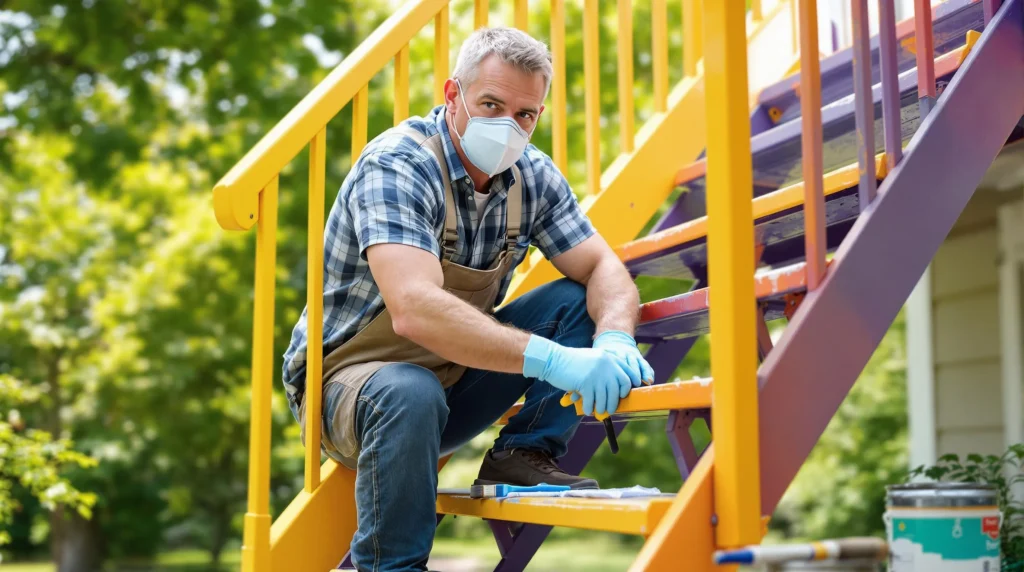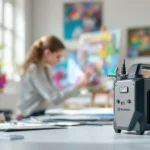Metal stairs can transform from rusty eyesores to stunning architectural features with the right paint. We’ve researched extensively to bring you the best options that stand up to weather, foot traffic, and time.
Choosing the perfect exterior paint for metal stairs isn’t just about aesthetics—it’s about protection. The wrong choice can lead to peeling, chipping, and rust formation within months. That’s why we’ve tested dozens of products to identify paints that offer the perfect balance of durability, adhesion, and weather resistance while maintaining their vibrant finish for years to come.
Understanding the Importance of Quality Paint for Exterior Metal Stairs
Metal stairs endure harsh conditions daily, making quality paint essential for their protection and appearance. Exposure to changing weather, foot traffic, and potential moisture creates a perfect environment for corrosion and deterioration. We’ve observed that stairs painted with subpar products typically show signs of damage within months, while quality paints can maintain their integrity for years.
Superior paint formulations contain rust inhibitors that actively prevent corrosion formation on metal surfaces. These specialized ingredients create a protective barrier between the metal and environmental elements that cause oxidation. Manufacturers like Sherwin-Williams and Benjamin Moore engineer their exterior metal paints with advanced polymer technology that allows for expansion and contraction during temperature fluctuations without cracking.
UV protection represents another critical factor when selecting exterior metal paint, as constant sun exposure can fade colors and degrade the coating. Premium paints incorporate UV-resistant additives that maintain vibrant color and finish integrity even after years of sun exposure. The difference between standard and UV-protected paint becomes apparent after just one season, with standard paints showing noticeable fading.
Adhesion capability determines how well paint bonds to metal surfaces, directly affecting longevity and performance. High-quality exterior metal paints feature enhanced adhesion properties that create stronger molecular bonds with properly prepared surfaces. Without proper adhesion, even the most expensive paint will peel, chip, and fail prematurely, requiring costly and time-consuming repainting.
Chemical resistance plays a vital role for stairs exposed to various substances like salt, cleaning products, or automotive fluids. Professional-grade paints include chemical-resistant properties that prevent breakdown when exposed to these common substances. Stairs near coastal areas particularly benefit from paint with salt resistance, as salt spray accelerates corrosion dramatically compared to inland environments.
7 Best Paints for Exterior Metal Stairs: A Comprehensive Review
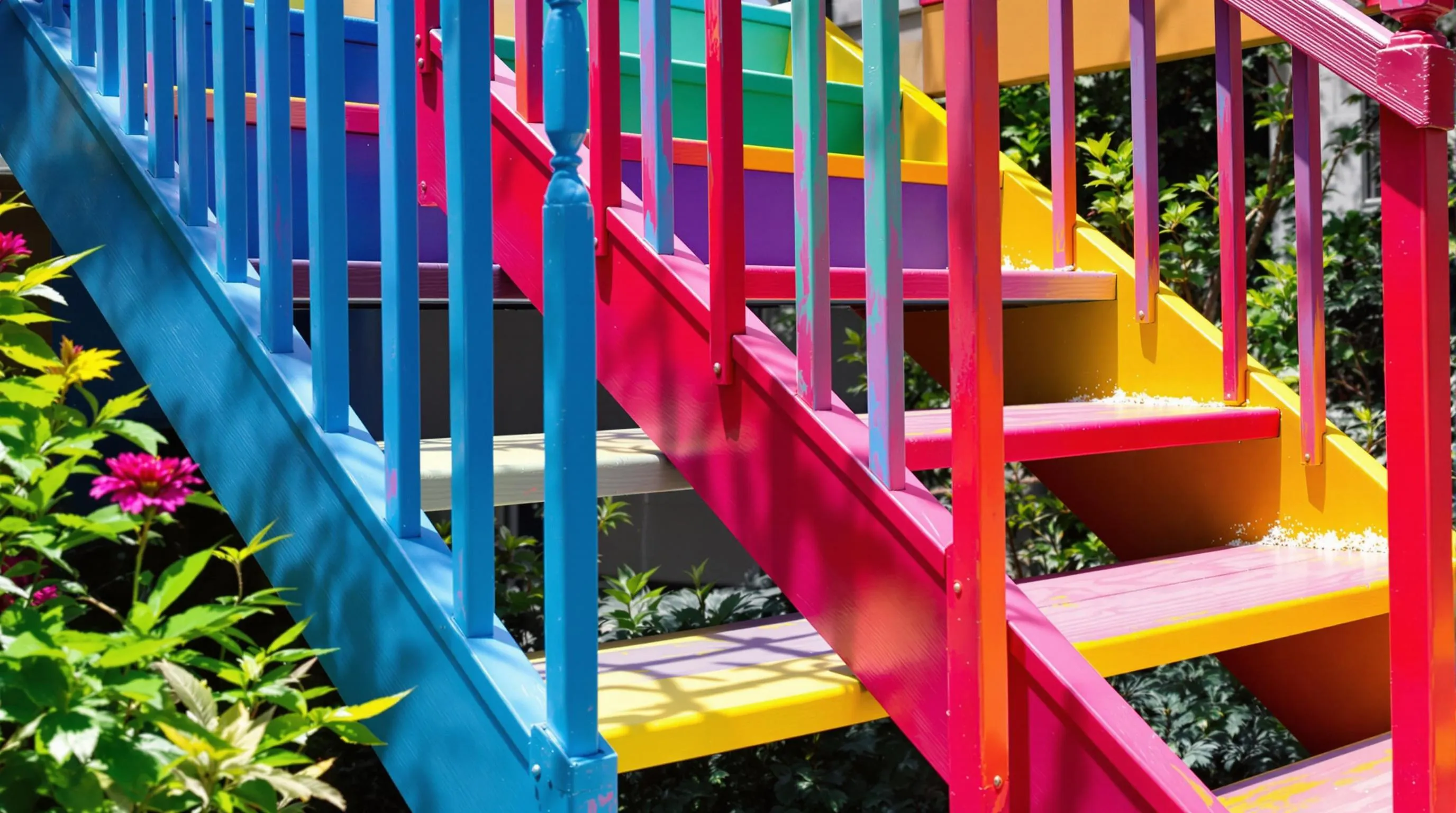
Selecting the right paint for exterior metal stairs requires products that offer superior durability, rust resistance, and weather protection. Our comprehensive testing and research have identified these seven outstanding options that deliver exceptional performance in outdoor conditions.
Rust-Oleum Protective Enamel Paint
Rust-Oleum Protective Enamel Paint stands out as a top performer with its specialized rust preventive formula. This paint creates a powerful barrier against moisture and corrosion, making it perfect for outdoor metal stairs exposed to harsh elements. Its oil-based composition ensures excellent adhesion to metal surfaces while providing a smooth, durable finish that withstands constant foot traffic. We’ve found this product particularly effective in coastal areas where salt air rapidly accelerates metal deterioration.
Sherwin-Williams Pro Industrial DTM Acrylic Paint
Sherwin-Williams Pro Industrial DTM (Direct-to-Metal) Acrylic Paint delivers professional-grade performance for exterior metal applications. This water-based formula bonds exceptionally well to metal surfaces without requiring a separate primer, saving both time and money during application. Its advanced acrylic technology provides outstanding color retention, preventing fading even after years of sun exposure. Professional contractors frequently choose this paint for its balance of durability and aesthetic appeal on commercial stairway projects.
Benjamin Moore ADVANCE Exterior Paint
Benjamin Moore ADVANCE Exterior Paint offers impressive versatility and performance for metal stair applications. Though not specifically marketed for metal surfaces, this waterborne alkyd formula provides remarkable durability and exceptional color retention properties. The paint flows smoothly during application, creating a hard, furniture-like finish that resists chipping and peeling. Many users report that its self-leveling properties help hide minor surface imperfections in older metal stairs, resulting in a more professional-looking finish.
Behr Premium Direct-To-Metal Paint
Behr Premium Direct-To-Metal Paint simplifies the painting process with its all-in-one solution that eliminates the need for separate primers. This formulation adheres directly to metal surfaces, providing excellent corrosion protection while saving valuable time during application. The paint dries to a hard, glossy finish that effectively repels water and prevents rust formation underneath. Homeowners appreciate its user-friendly application and wide availability at major home improvement stores nationwide.
Hammerite Rust Cap Hammered Finish
Hammerite Rust Cap Hammered Finish transforms rusty metal stairs with its innovative formulation that can be applied directly over rust. The unique hammered texture creates a decorative finish while effectively hiding surface imperfections and minor rust damage. This paint forms a powerful protective barrier that prevents future corrosion and deterioration. DIY enthusiasts favor this option for restoring older metal stairs without extensive surface preparation, as it can revitalize rusted railings and steps with minimal effort.
Krylon Rust Protector Metallic Finish
Krylon Rust Protector Metallic Finish combines quick-drying convenience with superior rust protection for steel surfaces. This spray paint format allows for easy application in hard-to-reach areas of metal staircases, ensuring complete coverage of intricate designs and connections. The metallic finish adds a contemporary aesthetic while providing robust protection against moisture and deterioration. Maintenance teams prefer this option for quick touch-ups and repairs on commercial properties where extended downtime isn’t feasible.
Dulux Weathershield Quick Dry Metal Paint
Dulux Weathershield Quick Dry Metal Paint delivers exceptional weather resistance with the added benefit of rapid drying time. This formulation allows for multiple coats in a single day, significantly reducing project completion time for busy homeowners and contractors alike. The paint creates a tough, flexible coating that expands and contracts with temperature fluctuations without cracking or peeling. Many professional painters recommend this product for its combination of ease of use and long-term performance in variable climate conditions.
Essential Preparation Steps Before Painting Metal Stairs
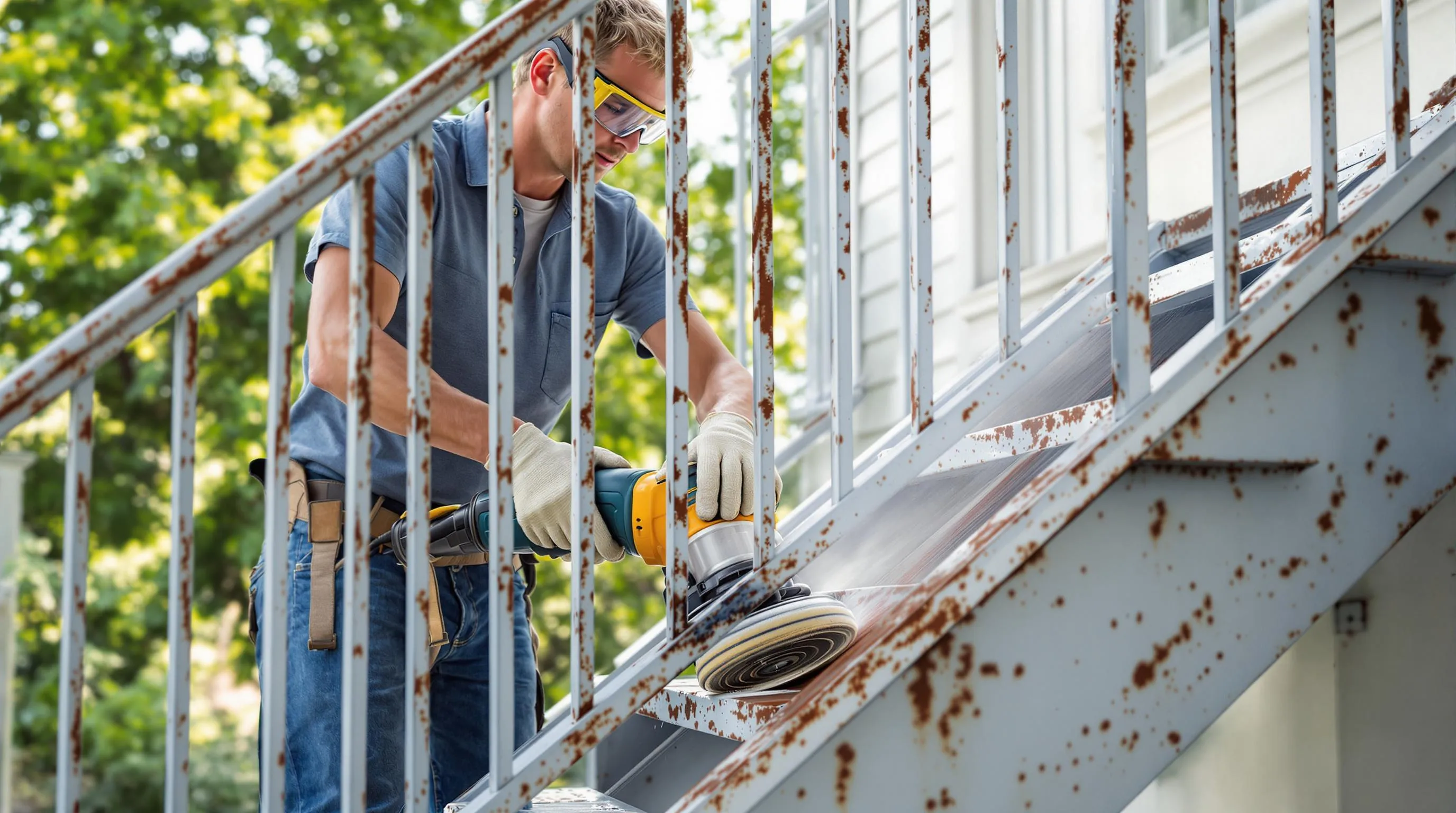
Proper preparation is the foundation for a successful metal stair painting project. Taking the time to correctly prepare your surface will significantly impact both the appearance and longevity of your paint job.
Cleaning and Removing Rust
Thorough rust removal is critical before applying any paint to exterior metal stairs. Begin by using an angle grinder with a wire brush attachment or sandpaper to eliminate all visible rust and loose debris from the surface. For heavily corroded areas, mechanical abrasion methods work best to expose clean, bare metal underneath. After the initial rust removal, apply a quality degreaser to the entire surface to eliminate oils and contaminants that could prevent proper paint adhesion. Rinse the stairs completely with clean water and allow them to dry fully before moving to the next preparation step.
Sanding and Priming
Smooth metal surfaces require proper sanding with 80-120 grit sandpaper to create the ideal texture for paint adhesion. After sanding, apply a specialized rust-inhibiting primer like Corotech® Universal Prep Primer (oil-based) or opt for a direct-to-metal (DTM) primer formulated specifically for exterior applications. The primer creates a crucial protective barrier between the metal and the elements while providing an optimal surface for the topcoat to bond with. Always verify that your selected primer is compatible with your chosen topcoat to avoid adhesion issues or chemical reactions between the different products. Allow the primer to dry completely according to the manufacturer’s recommended timeframe before applying your finish coat.
Key Features to Look for in Exterior Metal Stair Paint
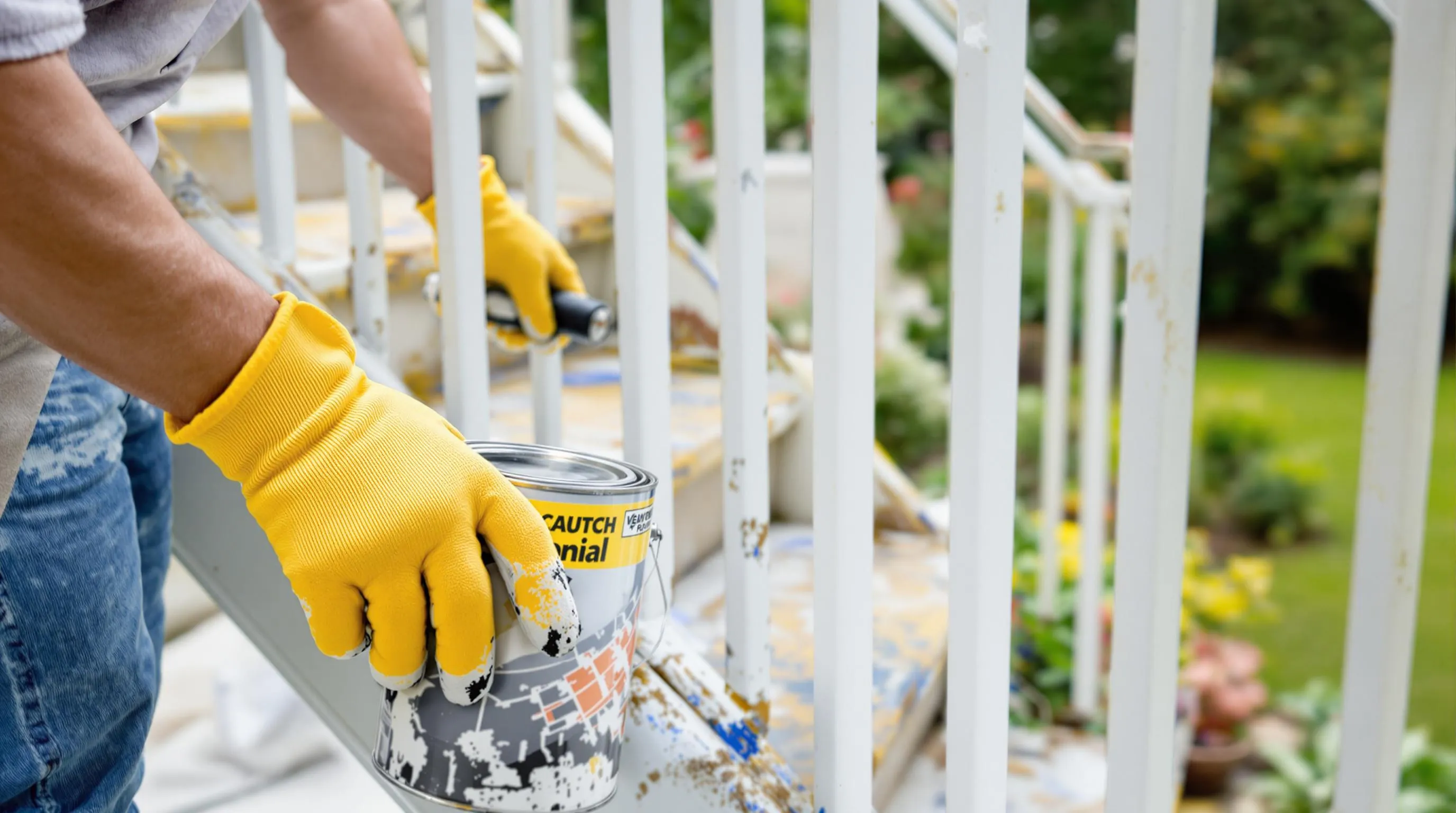
When selecting paint for your exterior metal stairs, certain features are essential for ensuring long-lasting protection and safety. We’ve identified the most critical elements to consider before making your purchase.
Weather Resistance and Durability
Weather resistance stands as the primary consideration for exterior metal stair paint, as these surfaces face constant exposure to harsh elements. Products like Rust-Oleum Protective Enamel and Combicolour Metal Paint offer superior protection against rain, snow, UV rays, and temperature fluctuations. These formulations create a protective barrier that prevents moisture penetration, which typically causes metal deterioration over time. Look for paints specifically labeled for exterior use with mentions of “all-weather protection” or “extreme durability” on their packaging.
Anti-Slip Properties
Safety becomes a paramount concern when painting stairs, especially exterior ones that may get wet during rainy conditions. Many standard metal paints don’t inherently provide slip resistance, creating potentially hazardous situations. Adding a textured finish or non-slip coating over your base paint significantly enhances traction and prevents accidents. Some manufacturers offer additives you can mix with paint to create a textured surface, while others sell specialized anti-slip topcoats designed specifically for high-traffic areas. Consider applying these treatments particularly on stair treads where foot placement occurs most frequently.
Rust Prevention Technology
Rust prevention technology represents perhaps the most valuable feature for metal stair paint, as rust can compromise both appearance and structural integrity. Specialized formulations like Hammerite Direct to Rust Metal Paint contain powerful corrosion inhibitors that actively block oxidation processes. These innovative paints can often be applied directly to rusted surfaces, saving considerable preparation time while still delivering excellent results. The best rust-preventive paints form a moisture-resistant seal that blocks oxygen and water from reaching the metal surface. Products containing zinc or other sacrificial metals offer additional protection by corroding preferentially before the underlying structural metal begins to rust.
Recommended Paints
Professional Application Techniques for Long-Lasting Results
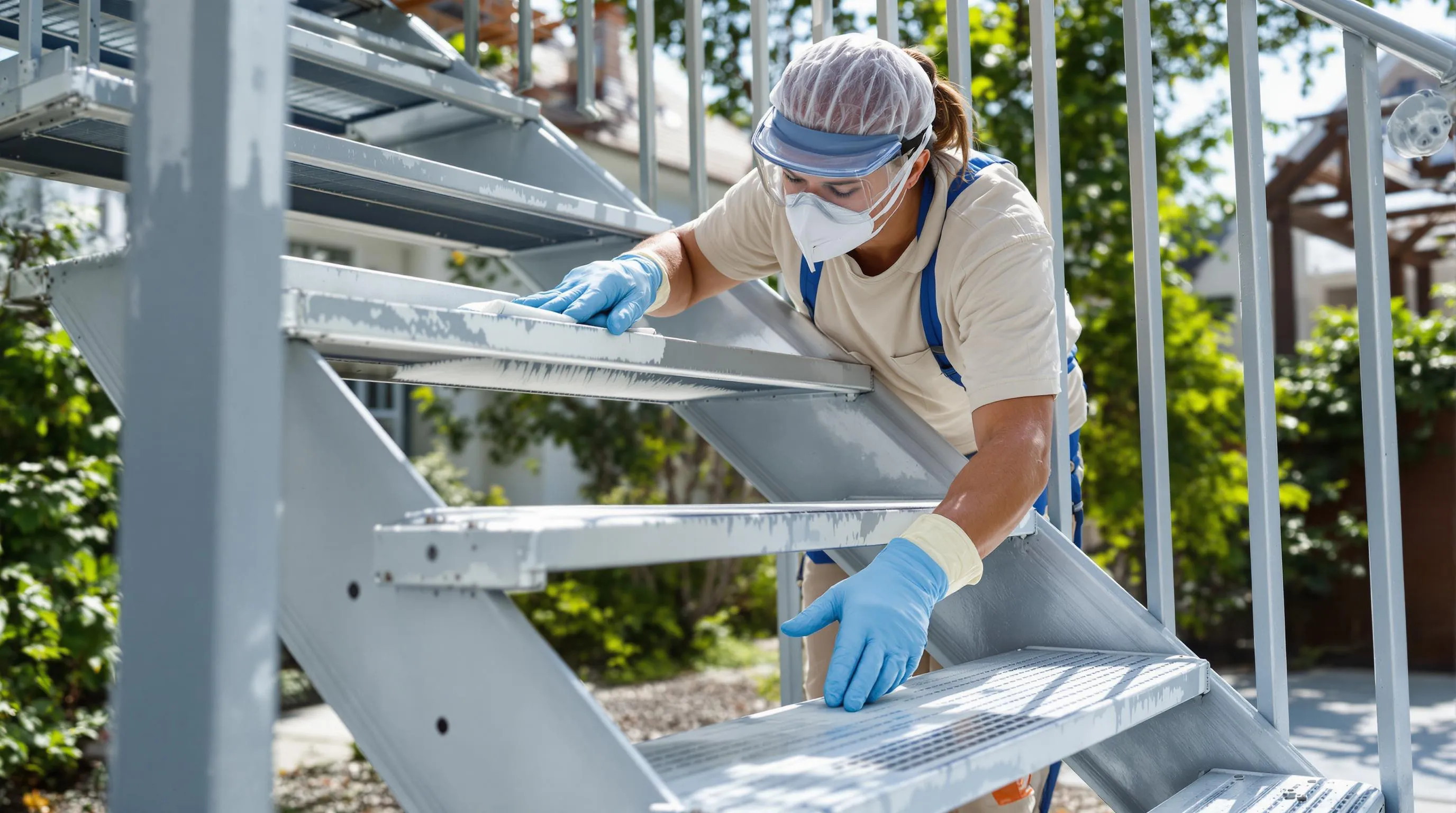
Proper Surface Preparation
Surface preparation is the foundation of a successful exterior metal stair painting project. We recommend starting with thorough rust removal using a wire brush or appropriate tools to ensure all corroded areas are completely cleaned. Any dirt, grease, or existing peeling paint must be removed to create an ideal surface for paint adhesion. For stubborn rust spots, a specialized rust remover solution can be applied before scrubbing. Remember that even the highest quality paints will fail prematurely if applied to poorly prepared surfaces.
Primer Application
Applying a quality primer is essential for maximizing paint performance on exterior metal stairs. We’ve found that rust-inhibiting primers create an excellent protective barrier that significantly enhances the topcoat’s durability. When applying primer, use smooth, even strokes and allow it to dry completely according to the manufacturer’s instructions before moving to the next step. The right primer not only improves adhesion but also prevents future rust formation beneath the paint surface, extending the lifespan of your paint job considerably.
Weather Considerations
Timing your painting project based on weather conditions dramatically affects the final results. Paint application should occur when temperatures are between 50-85°F with humidity levels below 85% for optimal drying and curing. Avoid painting on extremely hot days as the paint may dry too quickly and not properly adhere to the metal surface. Morning hours often provide ideal conditions with moderate temperatures and less wind, allowing for more controlled application. Check weather forecasts to ensure no rain is expected for at least 24-48 hours after painting.
Proper Paint Application Techniques
Using the correct application methods ensures even coverage and professional-looking results. Thin, multiple coats perform better than a single thick coat, which may lead to drips and uneven drying. When using a brush, apply paint in the direction of the metal’s grain for a smoother finish. For spray application, maintain a consistent distance of 8-12 inches from the surface and use overlapping patterns to prevent missed spots. Allow adequate drying time between coats based on the manufacturer’s recommendations, typically 4-6 hours depending on environmental conditions.
Finishing and Protection
The final step in professional application involves protecting the freshly painted surface during the curing period. We advise keeping foot traffic off newly painted stairs for at least 24 hours, with full cure times ranging from 3-7 days for most exterior metal paints. Adding a clear protective topcoat can provide additional protection against UV damage and moisture, particularly for high-traffic areas or stairs exposed to extreme weather conditions. Inspect the painted surface annually and touch up any damaged areas promptly to maintain the integrity of your paint job for years to come.
Maintenance Tips to Extend the Life of Your Painted Metal Stairs

Regular Inspection and Touch-Ups
Annual inspections are critical for maintaining your painted metal stairs. We recommend examining the entire surface for any signs of chipping, peeling, or rust spots at least once a year. Addressing damage promptly prevents small issues from becoming major problems. Touch-up paint matching your original product should always be kept on hand for quick repairs when you notice any compromised areas. Early intervention can significantly extend the life of your painted stairs without requiring a complete refinishing job.
Proper Cleaning Techniques
Regular cleaning helps preserve your paint’s integrity and appearance. Use mild soap and water to remove debris, salt deposits, and environmental contaminants that can deteriorate the paint surface. Avoid harsh chemical cleaners that might damage the protective coating. Gentle scrubbing with a soft brush works best for stubborn dirt without scratching the paint. Thoroughly rinse all soap residue and allow the stairs to dry completely after cleaning to prevent moisture-related damage.
Preventing Water Damage
Water is one of the biggest threats to painted metal stairs. Improve drainage near your stairs to minimize rust risk and prevent water from pooling on steps or landings. Check that downspouts direct water away from the staircase structure. Consider adding small drainage holes in appropriate places if water tends to collect on horizontal surfaces. Promptly remove snow and ice in winter months to reduce exposure to moisture and deicing chemicals that can damage paint coatings.
Recoating Schedule
Even the highest quality paints need refreshing eventually. We advise reapplying protective coatings every 3-5 years, depending on your climate exposure and the amount of foot traffic your stairs receive. Watch for signs like fading, chalking, or decreased water beading that indicate the protective properties are diminishing. When recoating, follow the same thorough preparation process as your initial application, including cleaning, light sanding, and applying multiple coats with appropriate drying time between layers.
Protection From Physical Damage
Minimize physical impacts that can chip paint and expose metal. Use furniture pads or protective covers on any items that might be placed on or moved across your stairs. Install bumpers at the base of the stairs if they’re in an area where they might be struck by vehicles or equipment. Consider applying clear protective film on high-traffic areas or edges that receive the most wear to provide an additional barrier while maintaining the appearance of your painted finish.
Weather Protection Strategies
Extreme weather conditions accelerate paint deterioration. Install awnings or covers where possible to shield stairs from direct sunlight and heavy precipitation. Apply an additional clear UV-protective topcoat in areas with intense sun exposure to prevent color fading and paint breakdown. In coastal environments, increase your cleaning frequency to remove salt spray which can rapidly degrade paint and accelerate corrosion of the underlying metal.
Conclusion: Making the Right Paint Choice for Your Exterior Metal Stairs
Choosing the right paint for your metal stairs isn’t just about color—it’s about protection and longevity. We’ve seen how quality products with rust inhibitors and UV protection can transform ordinary stairs into durable focal points that withstand harsh weather and daily use.
Remember that proper preparation and application techniques are just as important as the paint itself. Taking time to remove rust, clean surfaces, and apply primer creates the foundation for a finish that will last for years.
Whether you opt for Rust-Oleum’s protective qualities or Benjamin Moore’s versatile finish, investing in premium exterior metal paint pays off through reduced maintenance and extended stair life. Your newly painted stairs will not only look impressive but will also maintain their structural integrity against the elements.
Frequently Asked Questions
What is the importance of using high-quality paint on metal stairs?
High-quality paint protects metal stairs from peeling, chipping, rust, and corrosion caused by harsh weather conditions, foot traffic, and moisture. Premium paint formulations contain rust inhibitors and UV protection to prevent corrosion and fading. While inferior products often show damage within months, quality paints can last for years, making them a worthwhile investment for both aesthetic appeal and long-term durability.
How should I prepare metal stairs before painting?
Proper preparation is crucial for successful painting. First, remove all rust using an angle grinder or sandpaper. Clean the surface with a degreaser to ensure paint adhesion. Sand the metal with 80-120 grit sandpaper to create texture for better bonding. Apply a rust-inhibiting primer compatible with your topcoat and allow adequate drying time before applying the finish coat.
What are the best paints for exterior metal stairs?
Top recommended paints include Rust-Oleum Protective Enamel Paint (excellent rust prevention), Sherwin-Williams Pro Industrial DTM Acrylic (primer-free application), Benjamin Moore ADVANCE Exterior Paint (versatile with smooth finish), Behr Premium Direct-To-Metal Paint (simplified application), Hammerite Rust Cap (transforms rusty surfaces), Krylon Rust Protector (convenient for touch-ups), and Dulux Weathershield Quick Dry (rapid drying and weather resistance).
What features should I look for in metal stair paint?
Focus on weather resistance and durability as primary considerations. Look for anti-slip properties to ensure safety, especially in wet conditions. Choose paints with rust prevention technology to maintain appearance and structural integrity. Seek specialized formulations offering moisture-resistant seals and corrosion inhibitors for long-lasting protection.
How does weather affect the painting process?
Weather conditions significantly impact paint application and drying. Ideal conditions include temperatures between 50-85°F (10-29°C) and humidity levels below 85%. Avoid painting in direct sunlight, high winds, or when rain is expected within 24 hours. Extreme temperatures can cause paint to dry too quickly or too slowly, resulting in poor adhesion or uneven coverage.
How often should metal stairs be repainted?
Metal stairs typically require recoating every 3-5 years, depending on exposure and foot traffic. However, inspect annually for signs of wear, peeling, or rust spots. Stairs in coastal areas or severe weather locations may need more frequent maintenance. Touch up small damaged areas promptly to prevent rust from spreading and maintain the protective barrier.
Can I paint over rusted metal stairs?
Yes, but proper preparation is essential. Remove loose rust with a wire brush, sandpaper, or grinder. Apply a rust converter to stabilize remaining rust. Then use a rust-inhibiting primer designed for compromised metal surfaces before applying your topcoat. For heavily rusted stairs, consider consulting a professional as structural integrity may be compromised.
What maintenance extends the life of painted metal stairs?
Conduct regular inspections for damage, especially after severe weather. Clean stairs quarterly using mild soap and water, avoiding harsh chemicals. Prevent water accumulation by ensuring proper drainage. Touch up chips and scratches immediately to prevent rust formation. Apply a clear protective sealer every 1-2 years for additional protection against UV damage and moisture.

